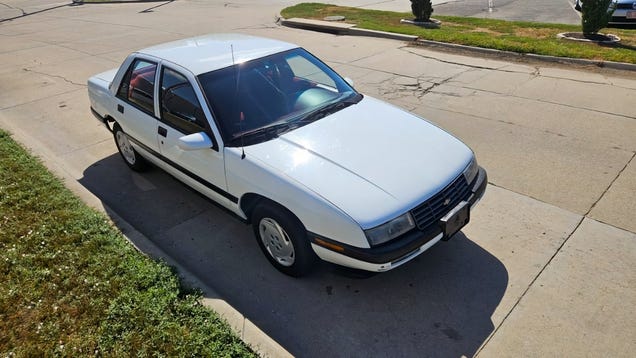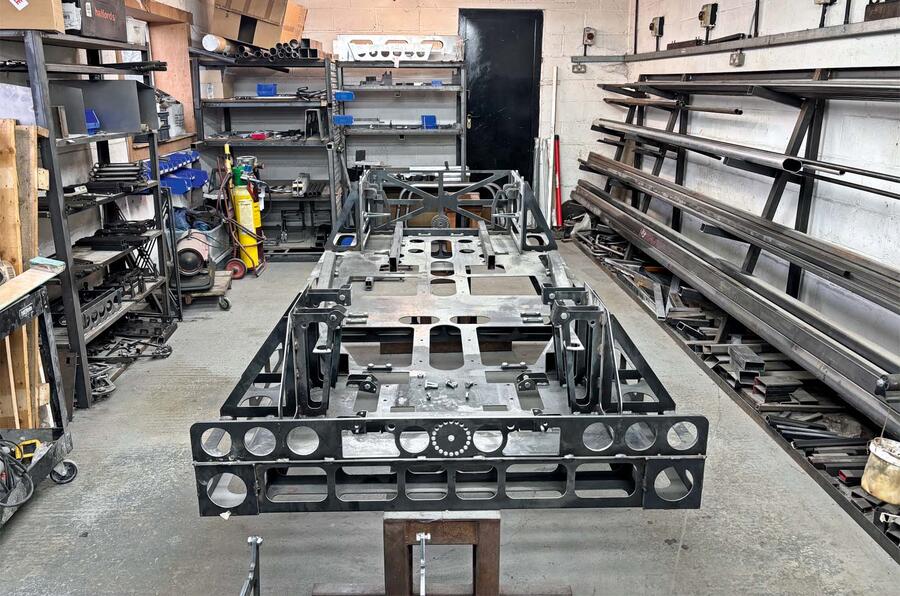Featured
“Buy $35M Go-Kart Track: Free Mansion, Castle & Stonehenge Replica!”

If you’re looking for a new house in the Guilford, Connecticut area and you absolutely must have a go kart track and oceanside views, this might be your only option. Located at 215 Uncas Point Rd., this 13-acre property—featuring a 5,354 square foot mega main house, a 3,583 square foot guest house, and an in-law suite …

“Card Game Maker Sues SpaceX for Trespassing on Land Bought to Prank Trump”

Elon Musk and his space exploration firm SpaceX are staring down the battle of a multi-million-dollar lawsuit from an unlikely source. No, the company isn’t being sued by ex-employees or locals pissed at all its rocket tests, it’s instead being sued for trespass by the makers of hit card game Cards Against Humanity.

“1993 Chevy Corsica: A $2,500 Bargain or Just Boring?”

If life as a whole is getting too overwhelming, then today’s Nice Price or No Dice Corsica might be the panacea for that agitation and festering angina. That is, as long as its price tag doesn’t piss us off.

“675kg Mika Meon: British Engineering Excellence | Giga Gears”
 Our road test editor dives into the technical make-up of the new VW Buggy-based EV
Our road test editor dives into the technical make-up of the new VW Buggy-based EV
Britain has a new lightweight sports car, the Mika Meon, and it has given me new hope about the potential of electrification within this particular micro-corner of the market.
Robin Hall and his team opened up the Mika office and workshop premises when I visited to test the Meon recently. Hall is a design engineer by trade. His company, Hall Engineering and Design, has been built on computer-aided design, which he does for all manner of clients.
He has a 3D printer in his office kitchen for producing prototype parts and a 3D scanner for the reverse engineering of existing ones. So there’s nothing antiquated, backwards or even particularly ordinary about this clean-sheet electric beach buggy design.
“Typically, the makers of niche sports cars like ours rely on a lot of parts bin components,” Hall told me.
“We’ve taken some off the shelf for the Meon, where that makes sense [ball joints, bushings and minor cabin components, for example]. But where we can get an advantage by designing our own parts – making them ourselves too, often – we will. That way, we needn’t adapt one part in order to squeeze in another; we get exactly what we want.”
The Meon’s brake calipers, for instance, are of Hall’s own design, machined from billet on site. Its front hub carriers are likewise proprietary, giving Hall ultimate control of attachment points and front-axle geometry (he previously designed the front hubs for the R50-generation Mini hatchback).
Hall is the kind of person who takes Henry Royce’s old maxim of “take the best that exists and make it better; if it does not exist, design it” rather seriously.
Mika’s chief technician, Dave Watt, showed me how the Meon’s chassis and axles come together. Lengths of tube- and box-section steel come in one door, finished chassis eventually go out of another and a lot of cutting, bending, bolting and welding of metal – much of it done by hand – goes on in between.

“Wishbones are the fiddliest,” said Watt, having first shown me how he cuts steel to size on a lubricated band saw (a device about the size of a coffee table, which would make a real mess of the place if it went wrong) and then forms it using a tube bender (a big ratcheted lever bolted to the floor that bends tubes around purpose-made blanks of particular radii).
“I can weld a whole chassis in less time than it takes to make a full set of wishbones.”
The welding is fascinating. Most of it happens on a purpose-made chassis jig (designed by Hall) that takes up a good chunk of the workshop floor itself.
It looks like something from a 1950s racing Ferrari, complete with cutouts for easy access to joins and rotisserie-style mountings so that it can be rotated around its middle.
This is production tooling in the classic sense, although it still produces build quality accurate to within a couple of millimetres across the car’s total length.
Watt slots each perfectly formed chassis member into it, then sets about joining them with spot welds first (“so the metal doesn’t warp and move as it cools”) and the bigger seam welds after.
When he’s finished, the Meon is four times more torsionally rigid than a Lotus Seven-style sports car typically is – and complete with batteries, seats, wheels and trim, it still weighs less than 700kg. Amazing.
As long as Britain’s cottage industry car business is in the hands of people like Hall and Watt, you can believe that they’re very capable and safe ones and they can still do remarkable things.
Microlino Review | Giga Gears
 Quirky, fashion-focused microcar is a Citroën Ami-sized EV for Kia Picanto money
The Citroën Ami is not a very good car, but then it's not really a car at all, rather a quadricycle. And besides, at less than £8000, it merits forgiveness of some of its more aggravating quirks and flaws. Despite its comparable dimensions and similar conception, you will find it distinctly harder to overlook any shortcomings of the new Microlino, which costs more than twice as much as its cubic contemporary.Revealed way back in 2016 and launched in Europe in 2022, the Microlino is the first 'car' from Switzerland's Micro Mobility Systems, founded in the late 1990s by Wim Ouboter, creator of the original foldable, two-wheeled aluminium scooter. Did you know there was originally meant to be one of those in the boot of every Smart car? Anyway, that never worked out, and there's clearly not as much money in the scooter game as there used to be, so Wim's son Merlin has taken the company boldly into the EV game with a tiny urban runaround modelled on the 1950s Isetta.Obvious stylistic influence from the era-defining 'bubble car' – famously built under licence by a nascent BMW – extends to a side-hinged front door, mirror-mounted headlights and a somewhat austere cockpit - although the Microlino's creators highlight the addition of a second rear wheel and, crucially, a reverse gear as key improvements.The Microlino is now available in the UK now through specialist vehicle retailer Krazy Horse, which conveniently will also sell you a Morgan Aero 8 supercar or a 2.5-tonne, 5.7-litre V8-engined Ram 1500 pick-up truck. Why go anywhere else?It's optimistic about the Microlino’s performance in the UK, targeting around 1000 sales here next year, and notes healthy demand from areas outside of the main cities – particularly on the south coast, where it will make a lot of sense, you’d imagine, as a holiday-home runabout.Motorhome owners have also emerged as a core demographic, to the extent that an Irish company is already designing a trailer specifically for the Microlino to be lugged along to the campsite, where it can be deployed for beach trips. But it will most naturally be at home as a second car for station runs and supermarket runs, with a footprint that lends itself to inter-urban errands and negotiating tight car parks - plus performance stats that stack up favourably against pretty much all of the same-sized alternatives, as you might hope, given the healthy premium it commands over each of them.
Quirky, fashion-focused microcar is a Citroën Ami-sized EV for Kia Picanto money
The Citroën Ami is not a very good car, but then it's not really a car at all, rather a quadricycle. And besides, at less than £8000, it merits forgiveness of some of its more aggravating quirks and flaws. Despite its comparable dimensions and similar conception, you will find it distinctly harder to overlook any shortcomings of the new Microlino, which costs more than twice as much as its cubic contemporary.Revealed way back in 2016 and launched in Europe in 2022, the Microlino is the first 'car' from Switzerland's Micro Mobility Systems, founded in the late 1990s by Wim Ouboter, creator of the original foldable, two-wheeled aluminium scooter. Did you know there was originally meant to be one of those in the boot of every Smart car? Anyway, that never worked out, and there's clearly not as much money in the scooter game as there used to be, so Wim's son Merlin has taken the company boldly into the EV game with a tiny urban runaround modelled on the 1950s Isetta.Obvious stylistic influence from the era-defining 'bubble car' – famously built under licence by a nascent BMW – extends to a side-hinged front door, mirror-mounted headlights and a somewhat austere cockpit - although the Microlino's creators highlight the addition of a second rear wheel and, crucially, a reverse gear as key improvements.The Microlino is now available in the UK now through specialist vehicle retailer Krazy Horse, which conveniently will also sell you a Morgan Aero 8 supercar or a 2.5-tonne, 5.7-litre V8-engined Ram 1500 pick-up truck. Why go anywhere else?It's optimistic about the Microlino’s performance in the UK, targeting around 1000 sales here next year, and notes healthy demand from areas outside of the main cities – particularly on the south coast, where it will make a lot of sense, you’d imagine, as a holiday-home runabout.Motorhome owners have also emerged as a core demographic, to the extent that an Irish company is already designing a trailer specifically for the Microlino to be lugged along to the campsite, where it can be deployed for beach trips. But it will most naturally be at home as a second car for station runs and supermarket runs, with a footprint that lends itself to inter-urban errands and negotiating tight car parks - plus performance stats that stack up favourably against pretty much all of the same-sized alternatives, as you might hope, given the healthy premium it commands over each of them. 